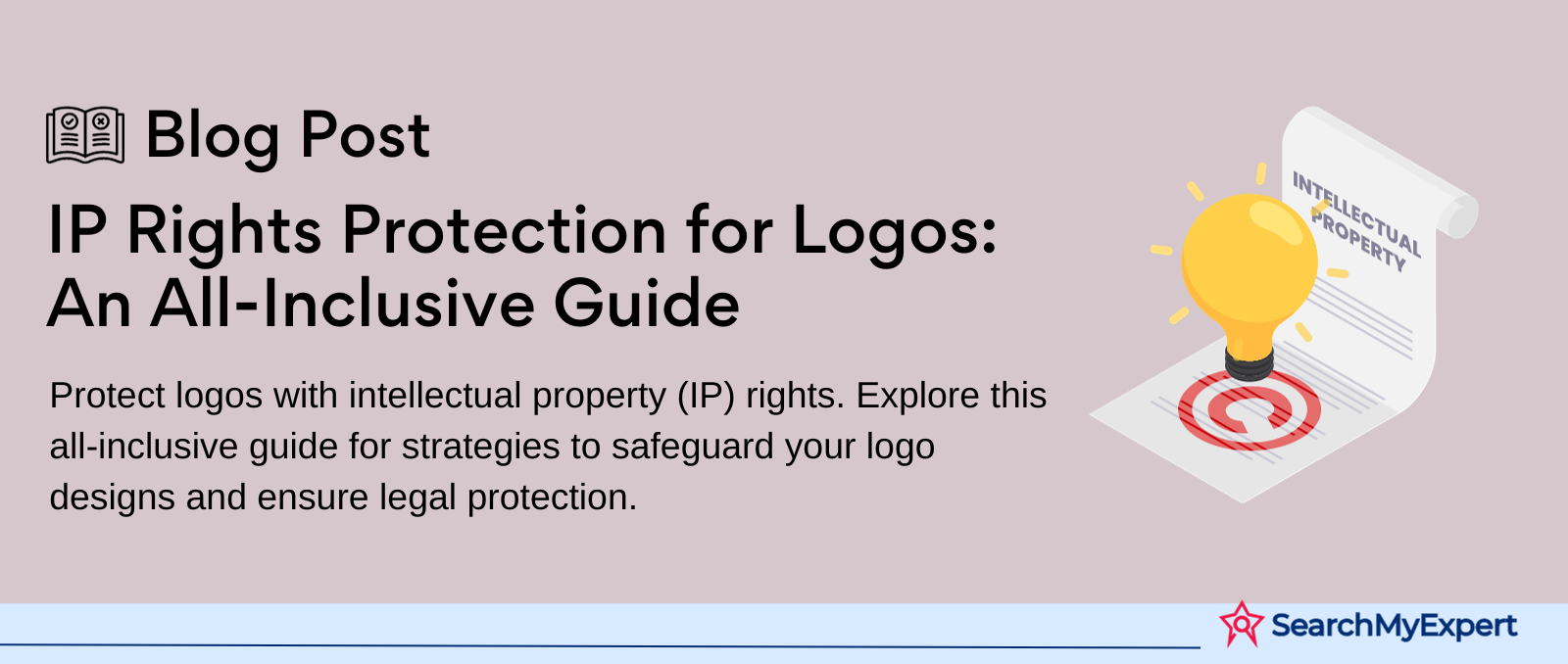IP Rights Protection for Logos: An All-Inclusive Guide

The Power of Logos in Branding and Intellectual Property Protection
Logos are more than just artistic symbols; they are the heart of a brand's identity. A logo is often the first interaction a customer has with a brand. It's a visual representation that conveys the essence, values, and distinctiveness of a brand. This symbolic significance makes logos not just critical for branding but also a valuable piece of intellectual property (IP).
Intellectual Property (IP) rights play a pivotal role in safeguarding logos. These rights ensure that a logo, as a unique creation, is legally protected from unauthorized use. By securing IP rights, a company can maintain its brand integrity, ward off counterfeiters, and build a strong, recognizable brand presence in the market.
In this exploration, we dive into the fascinating world of logos in branding and the vital role of intellectual property rights in their protection. We'll unravel why logos are integral to a brand's identity and how IP rights shield these valuable assets, fortifying a brand's position in the competitive market landscape.
Copyright Protection for Logos: Shielding Artistic Expression
Copyright Protection for Logos
In the realm of branding, logos stand as the vanguard of a company's identity. These symbols, however, are not just mere markers; they are original artistic expressions deserving legal protection. This is where copyright comes into play. Copyright is a form of intellectual property law that specifically guards authors of “original works of authorship,” including logos, from unauthorized replication or use.
Elements Eligible for Copyright
- Shapes: The geometric or abstract shapes that compose a logo are protectable, provided they are unique and not generic.
- Colors: When used distinctively, colors in a logo can be protected, especially if they form a recognizable pattern or design.
- Fonts and Typography: Unique typographic styles or font designs created for a logo fall under the protection scope.
Limitations of Copyright
While copyright is a robust shield, it has its limitations. It primarily guards against direct copying or near-identical replication of a logo. What it does not do is protect against the use of similar ideas or concepts. For instance, a logo with an apple might be protected, but the concept of using an apple in logos generally is not. This limitation necessitates a nuanced understanding of copyright law, especially in the sphere of logos and branding.
Understanding these nuances is crucial for companies to effectively protect their brand identity and navigate the complex world of intellectual property rights. As we delve deeper into the intricacies of copyright in relation to logos, it becomes apparent that while copyright is a powerful tool, it is not a catch-all solution and should be part of a broader strategy for intellectual property protection.
Trademarking Logos: A Brand's Badge of Distinction
Trademarking Logos
While copyrights protect artistic works, trademarks serve a different purpose. They are all about brand identification. A trademark is a sign capable of distinguishing the goods or services of one enterprise from those of other enterprises. When it comes to logos, trademarking them turns these symbols into exclusive identifiers for a brand or company.
Benefits of Trademark Registration
- Exclusive Rights: Registered trademarks grant exclusive rights to use the logo in relation to the goods or services it represents.
- Legal Recourse: In case of infringement, a trademark provides a legal basis for a lawsuit to protect the brand’s identity.
- Brand Value: Trademarks can increase in value over time, becoming an asset as the brand grows.
Criteria for Trademark Eligibility
To qualify for a trademark, a logo must meet certain criteria:
- Distinctiveness: The logo must be distinctive enough to identify a particular brand.
- Non-Descriptive: It should not be descriptive or generic regarding the goods or services it represents.
- Not Misleading: The logo shouldn’t mislead the public about the nature of the products or services.
Understanding the distinction between copyrights and trademarks, and the specific advantages and requirements of trademarking, is crucial for businesses. It ensures that their logos not only embody their brand identity but are also legally fortified against misuse, enhancing their market presence and value.
Design Contract and Ownership Clarification: Securing Rights in Logo Creation
Importance of Clear Agreements in Logo Design
When it comes to logo design, the line between creator and client is often blurred. It is crucial to establish clear agreements regarding intellectual property (IP) ownership. This clarity ensures that both parties understand who holds the copyright and/or trademark rights to the final logo. Without such agreements, disputes can arise, potentially leading to legal complications.
Standard Practices for Transferring Rights
- Written Contracts: Clearly outline the terms of IP ownership transfer in a written contract.
- Specifics of Transfer: Specify whether the rights being transferred are copyrights, trademarks, or both.
- Payment Terms: Often, the transfer of rights is contingent upon full payment for the design services.
Legal Implications of Unclear Ownership
Unclear ownership clauses in design contracts can lead to:
- Disputes Over Usage: Without clear ownership, both parties might claim the right to use or modify the logo.
- Challenges in Enforcement: Enforcing IP rights becomes difficult if it's unclear who legally owns the logo.
- Potential Litigation: Ambiguity can lead to legal battles over the ownership and use of the logo, which can be costly and time-consuming.
Avoiding Logo Infringement: Navigating the Legal Landscape
Defining Logo Infringement
Logo infringement occurs when a logo too closely resembles an existing copyrighted or trademarked logo, leading to confusion. This not only affects the infringing party but also the original creator or business owner. The consequences can range from legal battles to reputational damage, making it a critical issue in the design and business world.
Tips to Avoid Infringement
- Conduct Research: Before finalizing a logo, research existing logos to ensure your design is distinct.
- Hire Professionals: Professional designers are often well-versed in avoiding infringement issues.
- Understand IP Laws: A basic understanding of intellectual property laws helps in creating original designs.
- Get Feedback: Seek opinions from various sources to gauge if your logo inadvertently resembles another.
The Role of Thorough Trademark Searches
Conducting a comprehensive trademark search is crucial. It helps identify any existing logos that may be similar to your design, reducing the risk of infringement. This step is often overlooked but is essential in safeguarding your logo against legal challenges and ensuring it stands out in the marketplace.
Enforcement and Legal Remedies in Logo Infringement Cases
Legal Options for Addressing Infringement
When facing logo infringement, creators and businesses have several legal avenues to consider:
- Cease-and-Desist Letters: A formal request to stop the infringing activity.
- Lawsuits: Legal action can be taken for infringement, seeking damages or injunctions.
- Negotiation and Settlement: Parties may negotiate a settlement out of court.
The Importance of Legal Advice
In serious cases of infringement, it's crucial to seek legal advice. Experienced attorneys can provide guidance on the best course of action and help navigate the complexities of intellectual property law. They ensure that rights are adequately protected and that any legal action taken is sound and effective.
Alternative Dispute Resolution (ADR)
- Mediation: A neutral third party helps the disputing parties reach a mutually satisfactory resolution.
- Arbitration: An arbitrator listens to both sides and makes a decision, which can be binding or non-binding.
ADR can be a cost-effective and less adversarial way to resolve disputes. It's often quicker than litigation and can preserve business relationships.
Upholding the Integrity of Logos through Intellectual Property Rights
The Crucial Role of IP Rights in Logo Protection
Intellectual Property (IP) rights are the linchpin in safeguarding a logo's uniqueness and a brand's identity. They ensure that the creativity and effort invested in designing a logo are protected and valued. This protection not only secures the legal rights of the creator or business but also fortifies the logo as an asset, contributing to the brand's economic growth and market standing.
Resources for Further Information
For those keen on diving deeper into the intricacies of logo design and IP protection, here are some valuable resources:
- World Intellectual Property Organization (WIPO)
- United States Patent and Trademark Office (USPTO)
- The European Union Intellectual Property Office (EUIPO)
These platforms offer comprehensive insights into IP laws, processes for securing rights, and guidance on navigating the legal landscape of branding and logo design.
Conclusion
Respecting IP rights is not just a legal obligation but an ethical one. It recognizes the creativity and labor of designers and businesses, fostering a culture of innovation and fair competition. Economically, it contributes to the growth and stability of businesses, reinforcing the importance of logos as more than just symbols but as vital assets in the commercial world.
By understanding and upholding IP rights, we contribute to a more vibrant, respectful, and innovative business environment.
Bring your brand's vision to life with our Logo Designing Services.
share this page if you liked it 😊
Other Related Blogs

Mastering Docker for App Development: A Comprehensive Guide to Benefits, Use-Cases, and Alternatives
STAY UP TO DATE
GET PATH'S LATEST
Receive bi-weekly updates from the SME, and get a heads up on upcoming events.
Contact Us











